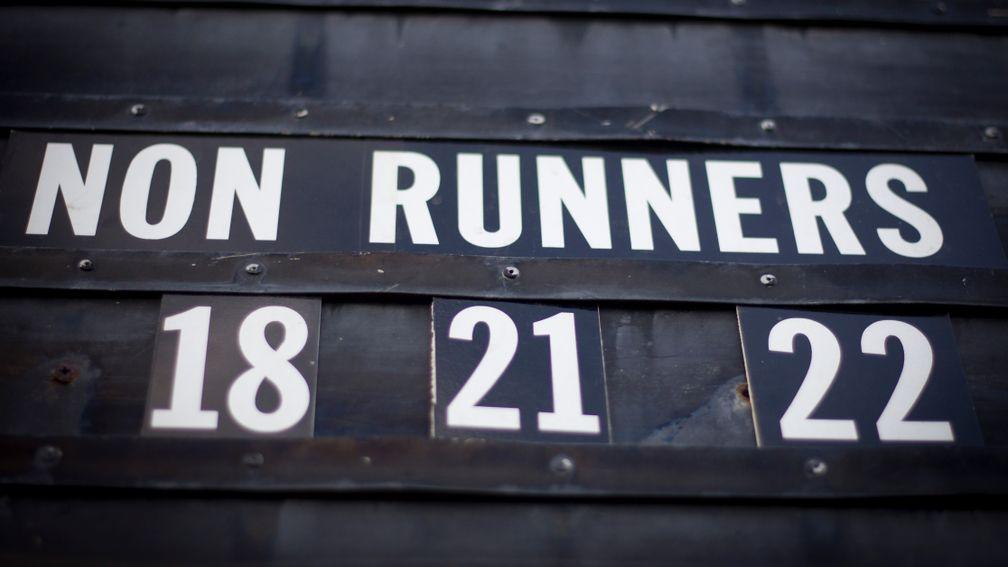Ten measures to tackle growing number of non-runners

Sweeping new measures designed to reduce the number of non-runners in British racing and weed out and punish serial offenders have been unveiled by the BHA.
Ten recommendations were published on Wednesday, which have been crafted to tackle the three categories that account for 90 per cent of absentees after declaration time – self-certificates, vets' certificates and going alterations, which last Wednesday was the prime reason behind a modern-day record of more than 100 non-runners on the day.
One of the key aims is to highlight and potentially punish what the BHA considers to be a small number of repeat offenders, who chief operating officer Richard Wayman was keen to differentiate from “the vast majority of trainers who operate within the spirit of the rules”.
The BHA's recommendations received varying degrees of support from representatives of bookmakers, punters, trainers and jockeys, but the Racehorse Owners Association criticised both the review process and at least one of its outcomes, describing the BHA's desire to see jockeys fully compensated for the loss of income incurred for a late non-runner as “completely unacceptable”.
The BHA will phase in the implementation of measures designed to reverse last year’s near eight per cent increase in non-runners, describing the programme as “proportional, balanced and targeted”.
Among the key recommendations are the publishing of quarterly league tables giving details of individual trainers’ records on non-runners as a percentage of their overall declarations.
An average level of non-runners will be established, and trainers who breach a threshold of 50 per cent above that average for any given period will have their permission to self-certify non-runners removed for 12 months.
The first set of tables will be published in October but, as each set deals with the 12-month period leading up to the statistics being made public, the BHA will not implement any sanction before the March 2018 set of figures.
Other eye-catching initiatives include a two-day quarantine period during which a horse cannot run once it has been withdrawn on a vet’s certificate, as well as that call for the ROA and Professional Jockeys Association to examine raising the amount paid to jockeys in the case of a raceday non-runner after 9am, from the current 40 per cent to the full riding fee.
The recommendations follow a review process initiated last autumn, when statistics made clear the previous three years' decline in the number of non-runners was on course to be reversed.

Wayman characterised the measures as having two broad purposes, saying: “We want to make sure the rules we have in place aren't being misused and that we can get these non-runners down to a minimum over the next few months and years.
“We've tackled it looking at it from two separate perspectives. First, we want to alter the behaviour of individual trainers with relatively high non-runner rates.
"There's quite a lot of focus on identifying who those trainers are and, indeed, publishing that information, and then taking some strong measures against those individuals who have a high rate. That's a big part of it.
“It is, of course, important trainers have the ability to withdraw horses for valid veterinary or welfare reasons, or if there's been a change in the going. But, equally, we must ensure such an ability is not misused.
'Spirit of the rules'
"We were also clear in compiling these recommendations we must not unfairly penalise the vast majority of trainers who operate within the spirit of the rules.
“The second part of the measures are linked to addressing specific behaviours linked with the most frequent reasons for non-runners - 90 per cent are either related to ground, self-certificates or vets' certificates.”
Among the measures in this second category are the introduction of raceday stewards’ inquiries for declared runners who have previously been withdrawn on a similar surface, and the two-day restriction on running a horse following the issue of a vet’s certificate.
The ten steps to reducing non-runners
The BHA will publish tables showing individual trainer non-runner rates from the previous 12 months at the end of each quarter.
Any trainer with more than 100 declarations in the period with a non-runner rate above a published threshold percentage (namely 50 per cent above the average non-runner rate) will be suspended from using self-certificates for 12 months.
Any trainer above the threshold but not included within the published data (owing to having fewer than 100 declarations during the previous 12 months) would have their situation reviewed. Any such trainer may be suspended from using self-certificates if it is considered appropriate by the BHA.
Any horse who has been declared as a non-runner with a vet’s certificate would not be able to race on the two days following the race.
Stewards to hold an inquiry where a horse is scheduled to run on identical going as that on which it had been withdrawn during the previous month because of the ground. Where a pattern arises or where it is considered circumstances warrant it, action may be taken such as preventing the horse from running.
The number of going-related non-runners will remain under close scrutiny, particularly when there has been only a marginal change in the going description. Should there be insufficient decline in the number of going-related non-runners, consideration will be given to the possibility of introducing a scale of going changes within the rules of racing and requiring a more significant change of going for a horse to be withdrawn, albeit with a greater degree of tolerance at the extremes of going.
All cases of a late change to going descriptions (ie. once racing has started), to be recorded and reviewed by the BHA, alongside situations in which a high percentage of horses are withdrawn having already arrived on the course. Where records indicate cause for concern the BHA racecourse inspectorate team will increasingly visit the relevant racecourse prior to race meetings to assess ground conditions and compare with the clerk’s going description.
BHA to encourage the ROA and PJA to agree that an owner will pay the full riding fee to the jockey of a non-runner declared after 9am on the day of the race. It is also proposed that this would take the place of any increase to the riding fee in 2018.
In cases where non-runners incur a fine, the fixed £140 fine is to be substantially increased for any such non-runners declared after 9am on the day of the race.
When considering whether to extend the 10am deadline for declarations under rule F (90), any trainer who has declared more than one horse will be treated as if a maximum of one declaration has been made.
The BHA also pledged to “substantially increase” the current £140 fine handed out to trainers for breaching rules on declaring non-runners, although what the new level will be has not been decided.
Wayman said the package of recommendations is designed to be customer-focused, with the interests of the betting public and the sport’s international customers at the forefront.
He described the need to maintain the highest level of animal welfare when embarking on such a drive as “a challenge”, but is confident the measures will not put adverse pressure on connections to run horses in unsuitable conditions or when they are not 100 per cent.
Wayman said: “We'll monitor the impact of the measures very closely and to ascertain whether there are any unintended consequences or, indeed, whether they achieve the desired reduction in non-runners we want to deliver.”
Lack of uniformity
The National Trainers Federation is understood to have successfully argued against the adoption of proposed going scales, which would have set limits to changes of going description below which a trainer would not be allowed to declare a non-runner.
The BHA accepted that a lack of uniformity in going descriptions made the immediate adoption of such a measure problematic.
“We're going to continue to monitor going-related non-runners particularly closely, especially when there's a relatively small change in ground conditions,” said Wayman.
“We'll come back to this particular recommendation once we've seen the impact of the measures and whether the numbers of non-runners have begun to fall the way we'd like to see.”
The BHA has set no public targets to measure such an ambition, but made clear it wishes to go further than just reversing the increases of 2016.
'A more gradual impact'
“What we'd like to do is get non-runners down to a minimum,” said Wayman. “We'd like to see a continual, gradual decline in the number of non-runners, both in the immediate future and the years ahead.
"That's really our focus, rather than picking a particular number. You could put in sanctions that could have immediate impact or, as we have done, go for behaviour change, which has a more gradual impact.”
The BHA said international yearly revenues generated by the use of 48-hour declarations on the Flat have risen from £6 million in 2006, when the system came in, to £16m – although the ROA queried the lack of analysis on the financial impact of a non-runner on British racing and underlined that 48-hour declarations are a key factor in why there are so many, last Wednesday being a case in point.
THREE UNDER-THE-BONNET QUESTIONS FOR THE BHA . . .
Will raceday inquiries envisaged in recommendation four place undue pressure on stewards?
The BHA says it is not anticipating this causing a logistical issue, and this has been discussed with stewards. Software will make the process of identifying horses who fall into this category simple, and it anticipates the number of inquiries required to be held will not be overbearing.
Would this still come into play if there were a change in going description during the course of a card?
The BHA says this needs to be “fleshed out” but, in theory, yes, as stewards will be inquiring as to why a horse was declared on ground that matches that on which it was withdrawn in the last four weeks. If the going then changes, it could be the explanation is then clear, i.e. rain was expected that would change the going, but the question should still be asked.
Recommendation nine speaks of "a substantial increase" to the £140 fine. What sort of ballpark might we be talking here?
This is expected to be finalised in the next week or so. The BHA says it will be “a penalty that is proportionate but at the same time provides a clear deterrent”.
Published on 16 August 2017inNews
Last updated 18:52, 16 August 2017
- The latest edition of the Racing Post is available to read online now - here's how you can access it
- How Smart View recorded a 76 per cent profit at the Cheltenham Festival
- Smart View is available on the Racing Post app - how to read the revolutionary new racecard
- Levy reform talks 'accelerating' as clock ticks down to April deadline for agreement
- Kieran Shoemark lands another plum Meydan ride for Gosden stable on Trawlerman in Saturday's Dubai Gold Cup
- The latest edition of the Racing Post is available to read online now - here's how you can access it
- How Smart View recorded a 76 per cent profit at the Cheltenham Festival
- Smart View is available on the Racing Post app - how to read the revolutionary new racecard
- Levy reform talks 'accelerating' as clock ticks down to April deadline for agreement
- Kieran Shoemark lands another plum Meydan ride for Gosden stable on Trawlerman in Saturday's Dubai Gold Cup